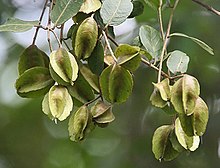Terminalia arjuna
| Terminalia arjuna | |
|---|---|
 |
|
| Arjuna fruit | |
 |
|
| Arjuna flowers with a Sykes's warbler | |
| Scientific classification | |
| Kingdom: | Plantae |
| (unranked): | Angiosperms |
| (unranked): | Eudicots |
| (unranked): | Rosids |
| Order: | Myrtales |
| Family: | Combretaceae |
| Genus: | Terminalia |
| Species: | T. arjuna |
| Binomial name | |
|
Terminalia arjuna (Roxb.) Wight & Arn. |
|
Terminalia arjuna is a tree of the genus Terminalia. It is commonly known as arjuna or arjun tree in English,thella maddi in Telugu, kumbuk in Sinhala, marudha maram in Tamil and neer maruthu in Malayalam.
The arjuna is about 20–25 metres tall; usually has a buttressed trunk, and forms a wide canopy at the crown, from which branches drop downwards. It has oblong, conical leaves which are green on the top and brown below; smooth, grey bark; it has pale yellow flowers which appear between March and June; its glabrous, 2.5 to 5 cm fibrous woody fruit, divided into five wings, appears between September and November.
The arjuna is usually found growing on river banks or near dry river beds in Bangladesh, Uttar Pradesh, Madhya Pradesh, West Bengal and south and central India. It is known as matthimara in Kannada, neer maruthu in Malayalam 'marutha maram' (marutham pattai) in Tamil, thella maddi (తెల్ల మద్ది) in Telugu and kohda in Rajasthan.
The arjuna is one of the species whose leaves are fed on by the Antheraea paphia moth which produces the tassar silk, a wild silk of commercial importance.
The arjuna was introduced into Ayurveda as a treatment for heart disease by Vagbhata (c. 7th century CE). It is traditionally prepared as a milk decoction. In the Ashtānga Hridayam, but was also mentioned in many ancient Indian vedas, and was a known practice for thousands of years, passed down by tradition, before vagbhata mentioned it in his writings. Vagbhata mentions arjuna in the treatment of wounds, hemorrhages and ulcers, applied topically as a powder. Arjuna is an excellent medicine for Heart, it has the capability to even reverse heart failure. The Arjuna plant (lat. Terminalia Arjuna) has traditionally been used to treat heart disease for centuries, which is why it got the nickname “Guardian of the heart.” It’s named after the hero of the famous epic “Mahabharata”, because of its protective effects. Arjuna is an evergreen tree of the Combretaceae family, which grows along the rivers of West Bengal in the drained beds of central and southern India. In Ayurveda,it’s considered a sacred plant.
...
Wikipedia
